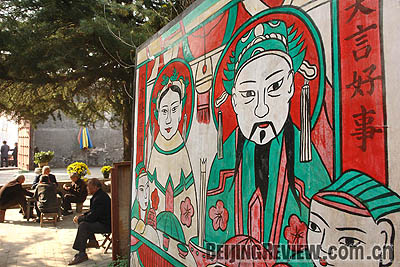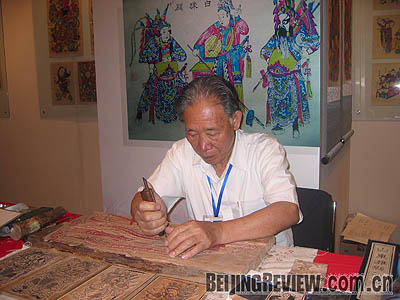|
 |
|
LIVING TRADITION: A large woodcut New Year picture exhibited in a museum in Zhuxian Town, Henan Province (XINHUA) |
"Door god, door god, rides the red horse, stands by the door and watches the house; door god, door god, carries a knife, keeps the ghosts away from the room." The "door god" in this popular Spring Festival rhyme is the main theme of China's woodcut New Year art, a tradition that has been passed down for generations.
As the Spring Festival, also known as the lunar New Year, approaches each year, the Chinese buy New Year pictures, including ones of the door god, to decorate their houses and pray for wealth and health for their families in the coming year. It is said that this tradition dates back 1,700 years. The pictures are an important part of the celebration, creating a strong festival atmosphere.
"Every Spring Festival, it is the New Year pictures that first create the festival atmosphere. The pictures are everywhere, and every household that can afford it has one. Without the pictures, the festival would be very tedious and dull," the famous author Tie Ning once wrote.
Despite the years of tradition behind them, woodcut New Year pictures are a dying art that many regard as outdated. Made by wood-block printing, they are in danger of disappearing.
Fight for revival
In January 2008, the International Forum on the Rescue, Protection and Development for the Woodcut New Year Pictures of China was held in Zhuxian Town, Henan Province. Five years ago, also in Zhuxian Town, the Chinese Folk Literature and Art Association launched a project to rescue Chinese cultural heritage with the rescue of Chinese woodcut New Year pictures as the main goal. The project has had great success in reviving woodcut New Year pictures.
"When woodcut New Year pictures are on the way to disappearing, we are forgetting our traditions," said Feng Jicai, Chairman of Chinese Folk Literature and Art Association. "Only when we reflect on our history, customs and culture can we pick up the heritage of New Year pictures."
In 2002, various government departments launched a nationwide survey on the condition of local woodcut New Year pictures. Up to now three quarters of them have completed the survey, and two thirds have created archives on local woodcut New Year pictures and senior picture painters. In 2006, the State Council announced the first batch of intangible cultural heritage of China, among which, woodcut New Year pictures occupy 12 items.
Talking about the achievements made in recent years, Feng feels satisfied. "It is our responsibility to rescue and protect cultural heritage, including woodcut New Year pictures. We are lucky because at least there is heritage for us to rescue. If we don't do it, I'm afraid that our next generation will have nothing to rescue."
From a small town to the world
Another topic of the forum in Zhuxian Town is to make preparations to apply for world intangible cultural heritage status for Chinese woodcut New Year pictures.
Zhuxian Town lies 10 km south of Kaifeng, an ancient capital of China. Among China's four most famous New Year picture producers, Zhuxian Town is the oldest. The other three are Yangliuqing in Tianjin Municipality, Wuqiang County in Hebei Province and Weifang City in Shandong Province.
The woodcut New Year pictures of Zhuxian Town are very impressive, with exaggerated images, bright colors, rough lines and full compositions. Some experts said the woodcut New Year pictures of Zhuxian Town are different from the delicate style of other places as their sculpting lines are very bold and rough, which is a unique characteristic of northern genre.
As the origin of woodcut New Year pictures, the local government of Kaifeng City and some non-government organizations have done much work to save the craft, including re-opening old craft workshops, collecting and copying old New Year pictures, and holding seminars on their protection. They have also made a film that records intangible culture surrounding the woodcutting craft.
After five years of rescue work, the heritage of Chinese woodcut New Year pictures has been effectively protected. Some new artistic elements and meaning have also been added, and a cultural industry with strong development potential has been built.
Yangjiabu, a village located near Weifang in Shandong Province, is also an important place for making woodcut New Year pictures. In recent years, Weifang Folk Literature and Art Association has created a "folk culture" brand, relying on local rich cultural heritage and Weifang Kite Festival. Now, about 100 households in the village make the New Year pictures. The annual output of the pictures from the village is about 15 million, which are sold all over the world.
"By our concerted efforts, the woodcut New Year pictures of China will be made popular across the world," said Feng.
New pictures, new development
"The reason why the New Year pictures were so popular in the past was that they stood for the fashionable culture. I want to make them a fashionable element in modern society," said Zhang Dianying, a well-known folk artist. "Only in this way can we really hand the craft down."
 |
|
MASTER AT WORK: Zhang Dianying, an expert in the art of making woodcut New Year pictures, demonstrates the craft (LIU YIZHAN) |
In the 1980s, Zhang took the lead by printing woodcut New Year pictures on the fashionable calendars, which sold very well. He also made albums using the pictures he had collected and T-shirts with the pictures printed on them, which have become very popular souvenirs and gifts.
"As for the woodcut New Year pictures, we should all inherit valuable elements from the traditional pictures as well as making some necessary renovations to keep up with modern society," said Wang Zhenjun, a professor of Zhengzhou University. "We have to involve pictures into people's daily lives. Apart from retaining the traditional subjects, we should also explore some new subjects."
Many people are contributing to the renovation and development of woodcut New Year culture throughout China. In May 2007, Wuqiang New Year Pictures Museum and Hebei University of Science and Technology reached an agreement to produce cartoon movies using the New Year pictures. Yangliuqing woodcut New Year pictures are now being designed for many new uses far removed from their original purpose, appearing on bowls, plates, kites, envelops, posters, stamps and calendars.
"The woodcut New Year pictures of China have a fascinating history of 1,000 years. As long as the entire society makes efforts together to protect and hand down the heritage, it will certainly enjoy a more promising future," said Feng with confidence. |
